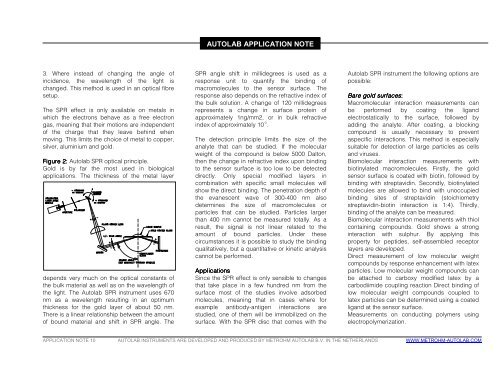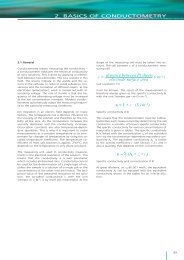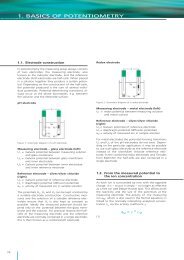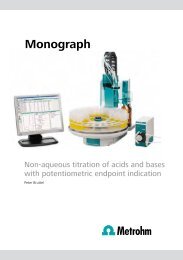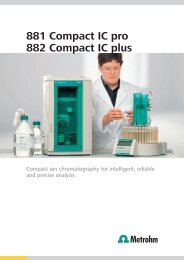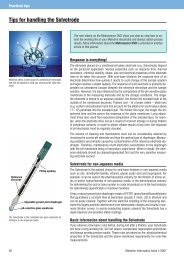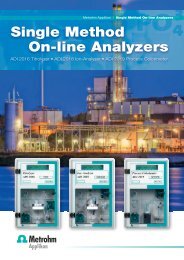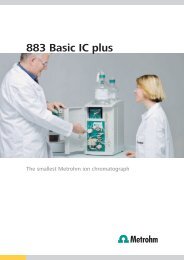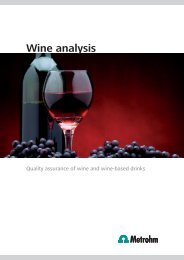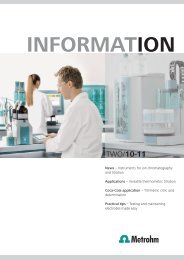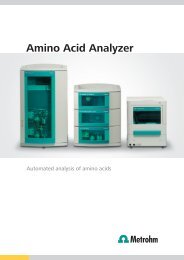Surface Plasmon Resonance with the Autolab SPR ... - Metrohm
Surface Plasmon Resonance with the Autolab SPR ... - Metrohm
Surface Plasmon Resonance with the Autolab SPR ... - Metrohm
- No tags were found...
You also want an ePaper? Increase the reach of your titles
YUMPU automatically turns print PDFs into web optimized ePapers that Google loves.
AUTOLAB APPLICATION NOTE3. Where instead of changing <strong>the</strong> angle ofincidence, <strong>the</strong> wavelength of <strong>the</strong> light ischanged. This method is used in an optical fibresetup.The <strong>SPR</strong> effect is only available on metals inwhich <strong>the</strong> electrons behave as a free electrongas, meaning that <strong>the</strong>ir motions are independentof <strong>the</strong> charge that <strong>the</strong>y leave behind whenmoving. This limits <strong>the</strong> choice of metal to copper,silver, aluminium and gold.Figure 2: <strong>Autolab</strong> <strong>SPR</strong> optical principle.Gold is by far <strong>the</strong> most used in biologicalapplications. The thickness of <strong>the</strong> metal layerdepends very much on <strong>the</strong> optical constants of<strong>the</strong> bulk material as well as on <strong>the</strong> wavelength of<strong>the</strong> light. The <strong>Autolab</strong> <strong>SPR</strong> instrument uses 670nm as a wavelength resulting in an optimumthickness for <strong>the</strong> gold layer of about 50 nm.There is a linear relationship between <strong>the</strong> amountof bound material and shift in <strong>SPR</strong> angle. The<strong>SPR</strong> angle shift in millidegrees is used as aresponse unit to quantify <strong>the</strong> binding ofmacromolecules to <strong>the</strong> sensor surface. Theresponse also depends on <strong>the</strong> refractive index of<strong>the</strong> bulk solution. A change of 120 millidegreesrepresents a change in surface protein ofapproximately 1ng/mm2, or in bulk refractiveindex of approximately 10 -3 .The detection principle limits <strong>the</strong> size of <strong>the</strong>analyte that can be studied. If <strong>the</strong> molecularweight of <strong>the</strong> compound is below 5000 Dalton,<strong>the</strong>n <strong>the</strong> change in refractive index upon bindingto <strong>the</strong> sensor surface is too low to be detecteddirectly. Only special modified layers incombination <strong>with</strong> specific small molecules willshow <strong>the</strong> direct binding. The penetration depth of<strong>the</strong> evanescent wave of 300-400 nm alsodetermines <strong>the</strong> size of macromolecules orparticles that can be studied. Particles largerthan 400 nm cannot be measured totally. As aresult, <strong>the</strong> signal is not linear related to <strong>the</strong>amount of bound particles. Under <strong>the</strong>secircumstances it is possible to study <strong>the</strong> bindingqualitatively, but a quantitative or kinetic analysiscannot be performed.ApplicationsSince <strong>the</strong> <strong>SPR</strong> effect is only sensible to changesthat take place in a few hundred nm from <strong>the</strong>surface most of <strong>the</strong> studies involve adsorbedmolecules, meaning that in cases where forexample antibody-antigen interactions arestudied, one of <strong>the</strong>m will be immobilized on <strong>the</strong>surface. With <strong>the</strong> <strong>SPR</strong> disc that comes <strong>with</strong> <strong>the</strong><strong>Autolab</strong> <strong>SPR</strong> instrument <strong>the</strong> following options arepossible:Bare gold surfaces:Macromolecular interaction measurements canbe performed by coating <strong>the</strong> ligandelectrostatically to <strong>the</strong> surface, followed byadding <strong>the</strong> analyte. After coating, a blockingcompound is usually necessary to preventaspecific interactions. This method is especiallysuitable for detection of large particles as cellsand viruses.Biomolecular interaction measurements <strong>with</strong>biotinylated macromolecules. Firstly, <strong>the</strong> goldsensor surface is coated <strong>with</strong> biotin, followed bybinding <strong>with</strong> streptavidin. Secondly, biotinylatedmolecules are allowed to bind <strong>with</strong> unoccupiedbinding sites of streptavidin (stoichiometrystreptavidin-biotin interaction is 1:4). Thirdly,binding of <strong>the</strong> analyte can be measured.Biomolecular interaction measurements <strong>with</strong> thiolcontaining compounds. Gold shows a stronginteraction <strong>with</strong> sulphur. By applying thisproperty for peptides, self-assembled receptorlayers are developed.Direct measurement of low molecular weightcompounds by response enhancement <strong>with</strong> latexparticles. Low molecular weight compounds canbe attached to carboxy modified latex by acarbodiimide coupling reaction Direct binding oflow molecular weight compounds coupled tolatex particles can be determined using a coatedligand at <strong>the</strong> sensor surface.Measurements on conducting polymers usingelectropolymerization.APPLICATION NOTE 10 AUTOLAB INSTRUMENTS ARE DEVELOPED AND PRODUCED BY METROHM AUTOLAB B.V. IN THE NETHERLANDS WWW.METROHM-AUTOLAB.COM


